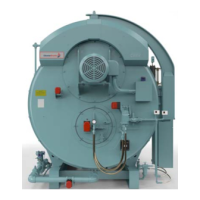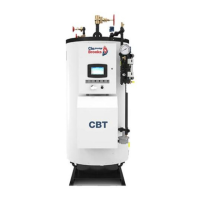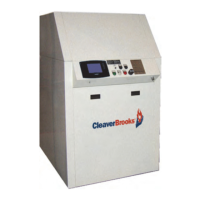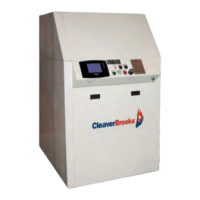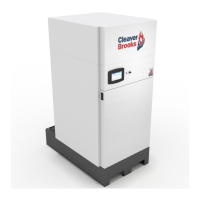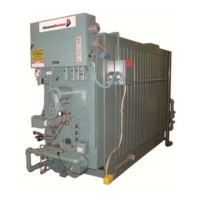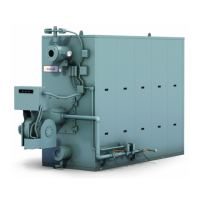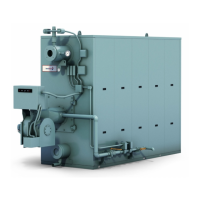Sequence of Operation
4-4
750-368
CBEX Elite 100-1200 HP
At the completion of the high fire purge period, the damper actuator will drive the air damper to its low fire posi-
tion.
To assure that the system is in low fire position prior to ignition, the Low Fire Relay (LFR) must be closed to
complete the low fire proving circuit. Once the low fire switch is closed, the sequence is allowed to continue.
4.4.2 — Ignition Cycle
The ignition transformer (IT) and gas pilot valve (GPV) are energized from the appropriate pilot ignition terminal.
The pilot flame must be established and proven by the flame detector (FD) within a 10 second period in order for
the ignition cycle to continue. If for any reason this does not happen, the system will shut down and safety lock-
out will occur.
With a proven pilot, the man fuel valve(s) (OV or MGV) is energized and the main fuel valve light (FVL) in the
panel is lit. The main flame is ignited and the trial period for proving the main flame begins. It lasts 10 seconds
for light oil and natural gas. At the end of the proving period, if the flame detector still detects main flame, the
ignition transformer and pilot valve are de-energized and pilot flame is extinguished.
4.4.3 — Run Cycle
With main flame established, the Release to Modulate Relay (RMR) switches operation to the Hawk firing rate
controls. Depending on the selection AUTO or MANUAL, control is accomplished through the Hawk HMI (man-
ual mode) or automatically based on the modulation signal and the current Hawk combustion settings.
The actuators for fuel, air, and FGR are positioned independently via Modbus signal.
The burner starting cycle is now complete. the LDL and FVL lights on the panel remain lit. Demand firing contin-
ues as required by load conditions.
NOTE: The ignition trial cannot be started if flame or a flame simulating condition is sensed during the pre-purge
period. A safety shutdown will occur if flame is sensed at this time.
NOTE: If the main flame does not light, or stay lit, the fuel valve will close. The safety switch will trip to lock out the
control. Refer to flame loss sequence (Section 4.5) for description of action.
NOTE: Depending upon the requirements of the regulatory body, insurer, or fuel being burned, either the 10 or 15
second pilot ignition terminal may be used. Both provide the same function but differ in time interval allowed for
proving main flame ignition. Refer to the boiler wiring diagram.
The cause for loss of flame or any other unusual condition should be investigated and corrected before attempting to
restart. Failure to follow these instructions could result in serious injury or death.
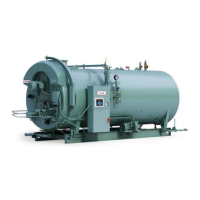
